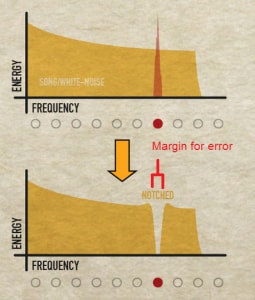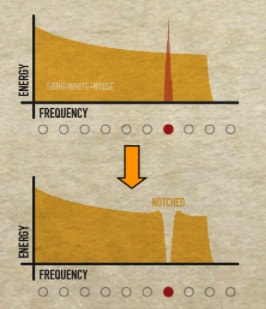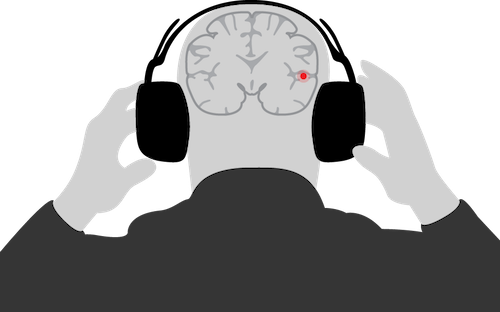Step 1: Find Your Tinnitus Tone
(click to expand)
If you are using an iPhone make sure that your ringer switch is on (switch on the side). Before you treat your tinnitus, you must identify the frequency of your tinnitus tone.
If your tinnitus frequency changes during the course of treatment, you can return here to detect it again.
- In a quiet place, connect your headphones to your device. Place them over your ears.
- Set the volume to a low level before you begin.
- Click on the Play button to listen to the program’s computer-generated tone.
- In the Wave Type drop down menu, select the tone that most closely matches the quality of your tinnitus tone.
- Move the slider back and forth until the frequency of the tone matches your tinnitus tone.
- Once you have matched the computer-generated tone with your tinnitus tone, click Create Therapy.
NOTE: You can set the volume using the audio level control of your computer and/or you can use the volume slider in the app.
NOTE: If you have already determined your frequency in an audiology clinic, enter it into the frequency box.
Having trouble? Check out our Tuning Guide, video walkthrough, or our extra tips below.
Video Walkthrough

If you're having trouble with hearing the tone, try using the Google Chrome internet browser.
Click Play
In order to listen to the computer-generated tinnitus tone, click the PLAY button. Before you do this, watch the volume! Listening to any sound if it's too loud can harm your hearing. Make sure you listen with a pair of good headphones that block out external noise.

Try to match the overall quality of your tinnitus tone to one of our options.
Match the quality of your tinnitus tone
Tinnitus tones come in various different categories. Some sound like a high-pitched "eeeeee" (like the "pure tone" example) and others sound like a hiss (like the "BB noise" example). To listen to different types of of tinnitus tones, select the drop down menu next to "Wave Type" - you can click or tap the text

You don't need to perfectly match your tinnitus tone.
Match the frequency of your tinnitus tone
Try to match the computer-generated tinnitus tone that AudioNotch is producing with your own tinnitus tone. Matches do not have to be perfect - an approximate match suffices because of the margin for error.
You can manually adjust the slider with a mouse, the arrow keys, or entering a number in the white box and hitting the play button.

If you have "pure tone" tinnitus, as long as you match your tinnitus frequency within the notch, you'll be okay.
How close do I have to be?
You do not need to have a perfect match. Assuming you have "pure tone" tinnitus (which sounds like a pure sine wave, or a clean whistling or humming sound), then as long as your "match" falls within the "notch" you'll be okay.
The notch width is two equivalent rectangular bandwidths (ERB). The ERB is dependent on frequency, so if your tinnitus frequency is 10,000 Hz (10 kHz), the ERB is about 1000 Hz, which means you'd have to get within a 1000Hz of your true tinnitus frequency.*
* (ERB = 107.94*f +24.7 = 107.94*10 + 24.7 = 1104 Hz).

Try to match the overall quality of your tinnitus tone to one of our options.
Wait a minute, what is octave confusion?
Once you have found your frequency, due to a phenomenon known as "octave confusion" it's possible that you have not actually found the correct frequency and instead mixed it up.
Find your tinnitus frequency F, which you believe to be your tinnitus tone.
- Then, compare F to 1/2F
- Finally, compare F to 2F
Pick the closest match among options 1-3, and you'll have checked to make sure you didn't experience "octave confusion," which could accidentally lead to an incorrect frequency match.

Only one Notch can be created at a time.
What if I have multiple tinnitus tones?
Notched therapy was only designed to treat one tinnitus tone at a time. Thus, we cannot claim that multiple tones are treatable based on the evidence we have. If you want, it's possible to make a track with multiple notches, but there are additional caveats.
Let's say you have two tinnitus tones t1 and t2 at two different frequencies, f1 and f2. To create a Notched Sound Therapy file with multiple notches:
- Notch White Noise at the first frequency, f1.
- Download the MP3 format file of "White Noise - Notched at f1."
- Upload the file from step (2) as a "song."
- Notch the song at f2 to create a second notch at f2.
- Now the file is notched at f1 and f2.
- Repeat as necessary for additional tinnitus frequencies f3, f4, etc...

Tinnitus frequencies seem to approximate a normal distribution within the range of human hearing.
What are the most common tinnitus frequencies?
We compiled a graph of user tinnitus frequencies and how commonly each tinnitus frequency was. Read more here.
What is Notched Sound Therapy?

For most people, tinnitus is a sound mistakenly created by their brain. This usually happens because the brain attempts to adjust for hearing loss.

"Notching" sound lowers the volume at a particular frequency. Notched Sound Therapy is audio that is "notched" at your tinnitus frequency.

Notched sounds help reverse your brain's adjustment error. As a result, Notched Sound Therapy can lower the volume of your tinnitus.
For a full explanation of the science, click here.
How Does AudioNotch Work?

Étape 1: Réglages
Use our tuner to match the frequency of your tinnitus tone.
The tuner is free to use on both our website and our app.

Étape 2: Création
Create "Notched Sound Therapy" using our preset sounds or your own music.
AudioNotch "notches" this audio for you.

Étape 3: Ecoutez
Listen to your "Notched Sound Therapy" daily.
Over weeks to months, your tinnitus volume should decrease.
You can listen to your therapy wherever you want.